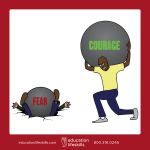Educators and administrators are still discovering what the new Every Student Succeeds Act (ESSA) means for schools, but most agree one change is positive for children. ESSA prioritizes social-emotional learning as critical to helping students develop the skills they need for success. Whether you’re developing a life skills curriculum or planning for the year ahead, teaching cognitive life skills will play a major role. Learn the core components of social-emotional learning (SEL) and how to bring positive thinking courses into the classroom today.
Social-Emotional Learning Competencies
There are five components of SEL that can be integrated into almost every lesson.
- Self-awareness – Students should gradually develop the skills necessary to identify their own thoughts, emotions, strengths and values. Doing so promotes self-confidence and a growth mindset.
- Self-management – Children can learn to not just monitor, but regulate their feelings to control impulses, manage stress and develop healthy habits.
- Social awareness – This competency focuses on developing empathy, showing respect and valuing diversity.
- Relationship skills – Students learn to communicate, work together in teams and respond appropriately in social situations.
- Decision-making – Children begin to respond to decisions by identifying problems, evaluating their options and taking responsibility for their own well-being.
6 SEL Teaching Tips
It sounds like a monumental task, but teachers don’t choose education because it’s easy. Approach social-emotional learning the same way you succeed at other subject matter, by working systematically toward your goal.
Start each day with an emotion check. Greet each student warmly as they arrive and invite them to identify how they feel. Early elementary students might refer to a chart with illustrations, and teachers can prompt older children to exchange the usual “happy” or “sad” for synonyms.
Use read-alouds to introduce social-emotional themes. Carla’s Sandwich is available free through Storyline Online and uses descriptive words to teach self-awareness, relationship skills and responsible decision-making. The Orange Shoes is a touching story children of all ages will enjoy as they learn social awareness.
Explicitly teach teamwork skills. Children frequently hear they should listen to others, share, and be thoughtful, but they may not know what that looks like in an educational setting. Negotiation and compromise are skills you can teach. Give students plenty of chances to work with partners for a strong classroom community.
Cultivate self-awareness through mindfulness. Human beings in general stay so busy they often don’t evaluate their own physical and emotional condition. Mindfulness involves pausing to turn thoughts inward and become aware without passing judgment. Prompt students daily to spend a few minutes noticing their breath, thoughts, emotions and the physical sensations they experience.
Let them take a break. Part of developing balance involves knowing when stress is reaching critical levels and having the ability to walk away. Create a place where students can regroup when they feel overwhelmed. Offer headphones that block noise, a journal or drawing pad and a comfortable space to find calm.
Close each day by allowing a few students to reflect on what they experienced during the day. Point out examples of optimism, self-control and good decision-making and encourage students to do the same.






